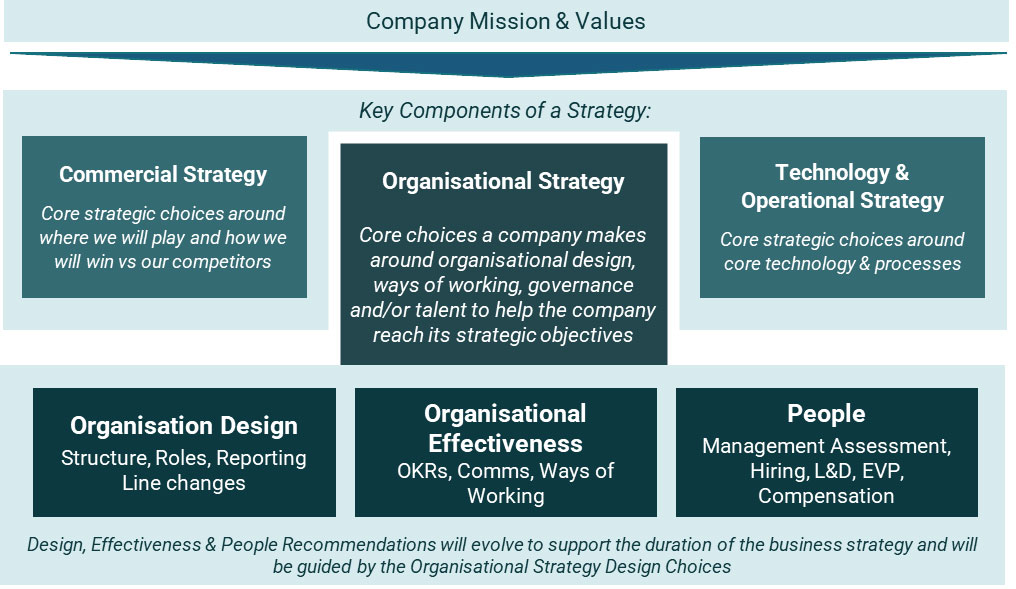As technology drives business transformation and fast-growing tech businesses re-imagine their operating models in the digital age, it’s time to revisit traditional approaches and thinking around Organisation Design (“OD”). The nature and complexity of companies in the hyper-growth phase are inherently different from what has come before, and the way in which they operate is more autonomous and experimental, testing traditional structures and organisational models.
Supporting theory & thought leadership around Organisation Design is arguably outdated, being largely based on the analysis of projects with more mature, established businesses. Tech Founders & CEOs therefore tend to look back at their career lessons learnt and lean on their peers for organisational advice due to the lack of true, high growth tech organisation design & effectiveness expertise in the market.
Not putting in place the right building blocks around Organisation Design will hinder longer term growth and is increasingly becoming the primary reason investments and businesses fail. Founders & CEOs need guidance on addressing the organisational imperative, but we must define a new approach that is more tailored to the needs of high growth tech businesses and a dynamic, ever-changing industry.
The Organisational context for high growth tech businesses
For years, big professional services firms have perfected the art of selling and delivering large-scale OD projects for established, mature and underperforming companies. This successful blueprint has enabled many of today’s biggest brands to overcome these people & organisational challenges and grow into more successful businesses.
The emergence of new and exciting Tech startups prompts us to challenge the model used for established businesses as well as the methodologies, underlying theory, and its application in the high growth tech space. As we pivot to the next generation of new Tech companies, we must acknowledge that the organisational context and implications for your organisation design are without doubt different:
- The Pace of Change: traditional OD approaches were initially created to assess more mechanistic, rigid organisational structures in a slower changing environment. To design and then implement OD changes can take months or even years (depending on the size of the company). If we adopt a similar approach for high growth tech businesses, by the time the activity is complete, the business will have already changed organically, rendering the exercise pointless. High growth tech companies operate in a rapidly changing, high velocity environment where actions and decisions need to be made quickly. Org design recommendations need to consider flexibility, innovation and how the organisation must quickly evolve over time.
- Business Maturity: it is likely that more established enterprises will have undergone multiple reorgs and had a long list of CEOs in their lifetime. A successful, high growth tech business is often taking a leap into the unknown, having disrupted a well-established industry or existing business model. Let’s look at new investment platforms and companies such as Bitpanda whose mission is to provide customers with easier access to digital assets. The world of Fintech & Crypto exchanges is still new and there’s a lack of historical industry knowledge, lessons learnt or case studies to compare against. Perhaps a blessing and a curse, yet, it has presented an opportunity for the Founders to put in place the first organisational foundations that are right for Bitpanda and shape the company’s evolution for years to come.
- Experimental Organisational Models: the emergence of new operating frameworks are more frequently tested and adopted by startups. Spotify pioneered the Squads & Tribes model to better manage multiple teams in a product development organisation. The Squad structure has since been adopted by companies such as Tibber who see this as core to their test and learn culture. Zappos went one step further and experimented with the Holacracy management methodology to altogether remove power from traditional hierarchies and redistribute it across self-managed and self-organised teams. Overall, Founders & CEOs prefer these new ways of working due to increased levels of creativity, autonomy, and productivity amongst employees. The implications on your org design include moving beyond traditional hierarchical models (less preferrable for emerging Tech companies) and putting greater importance on team ways of working, decision-making, collaboration, and effective communication.
- The Trigger & Approach: the trigger for org design should shift from being a “reactive” response (eg managing organisational efficiencies and deep restructuring) to a more “proactive” approach to designing for growth and scale. For high growth tech companies, the implications for your org design will focus on establishing the organisational fundamentals (e.g vision, values, and culture) and thinking through the right way to organise the business that will enable the next phase of hypergrowth. Structural implications for your org design will often consider splitting teams out or building new functions that are required as the business grows. At Vivino for example, changes included establishing a new commercial function to manage all revenue activities and separating out the Product & Technology to meet evolving organisational needs. This is in stark contrast to larger, corporate transformation projects that often look to consolidate and streamline functions.
These differences highlight the need for a changed approach; they also lead some to believe that OD is not a key business priority for high growth tech businesses – legacy issues don’t exist, inefficiencies are not the core problem and structures appear smaller and simpler. The “OD” brand needs to shift away from restructuring or ‘trimming the fat’ to building the organisational foundations for the future. This starts with establishing the core design choices and your “Organisational Strategy”.
Organisational Strategy first, then your Org Design
This is where High Growth Tech businesses & CEOs should begin. Do not be intimidated by the outcomes of past, large-scale OD projects in more established businesses and remember this exercise is about designing for scale and growth. Avoid the common Founder’s pitfall of deprioritising the organisational foundations for your business and start the process early.
An often over-looked, yet intrinsically linked part of business strategy, Organisational Strategy helps you outline how the company will deliver on its mission and objectives. Design choices provide a flexible framework that guides your organisational structure, broader ways of working, culture, and talent strategy, and aligns with the company’s commercial, technological and operational value proposition. Defining these core principles will ultimately inform where value is attributed structurally, how decisions should be made and what behaviours should be role modelled, acting as a critical point of reference as the business evolves.
Finally, design choices must critically serve the full duration of the business strategy. Per the definition above, organisational strategy is a core component of business strategy. Design choices must be used to guide different stages of organisational change – be that to the structure of the teams and how they quickly evolve to support the strategy or different mechanisms to optimise ways of working that underpin the design.
Re-focusing the Organisational Strategy & Design paradigm in this way will deliver real value to the business and strengthen the position of the organisation over the long term:
- It provides a framework and mechanism for leadership to effectively manage the everyday complexities that come with size and scale;
- It enables managers & employees to be truly effective in their roles;
- It clarifies who needs to be hired and when based on the skills and experience required; and
- Finally, an effective organisational strategy should also help you attract investment and secure the funding from current and prospective investors for the next phase of growth.
Read about our recent Organisational Strategy projects here, or get in touch to book a 30 minute consultation and discover how we can support you or your portfolio companies.



